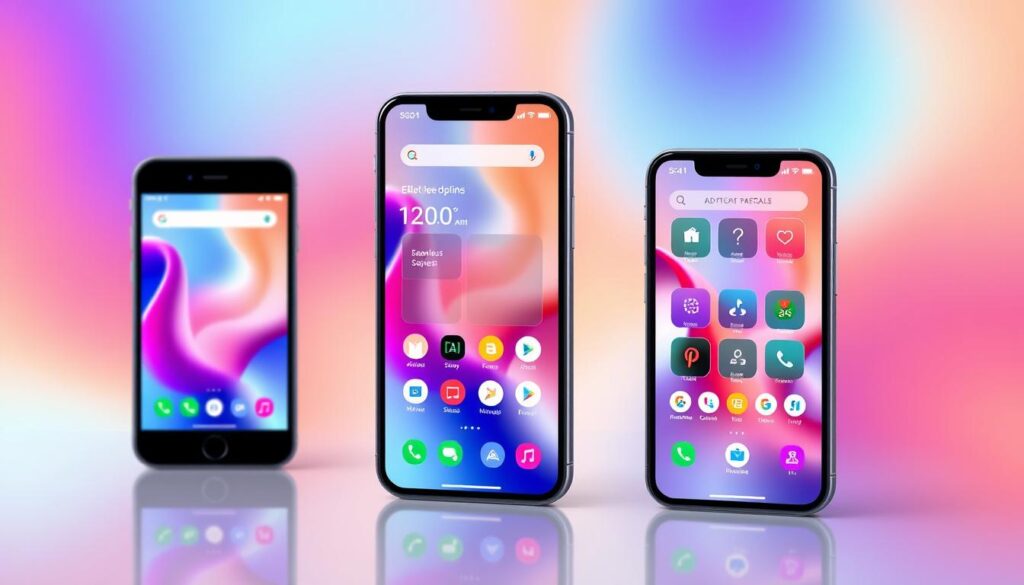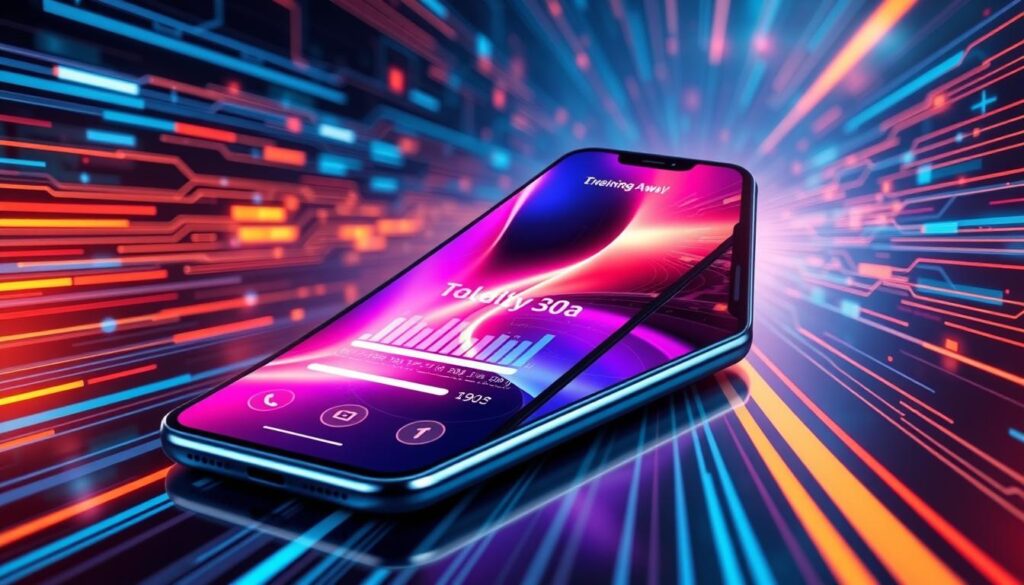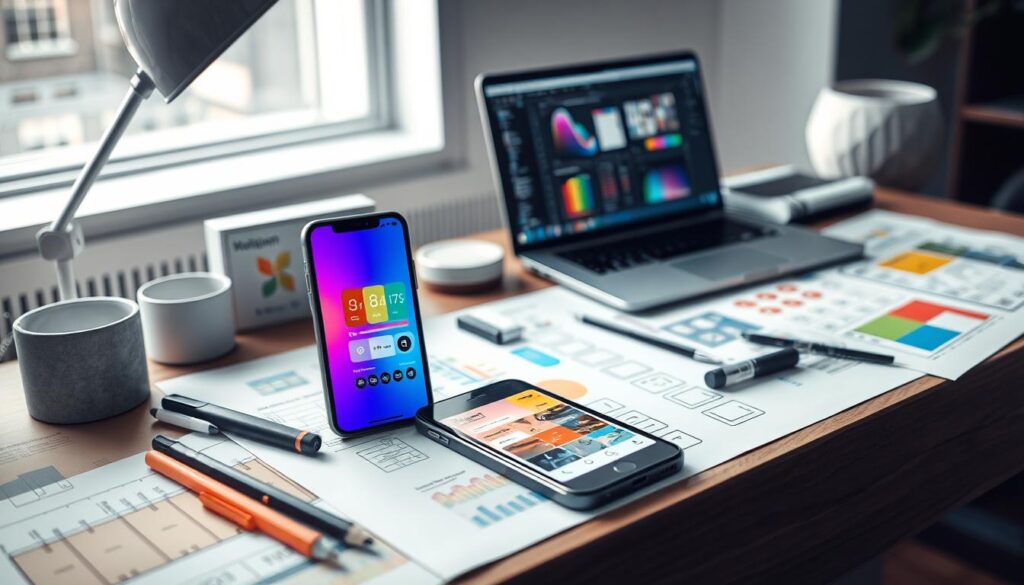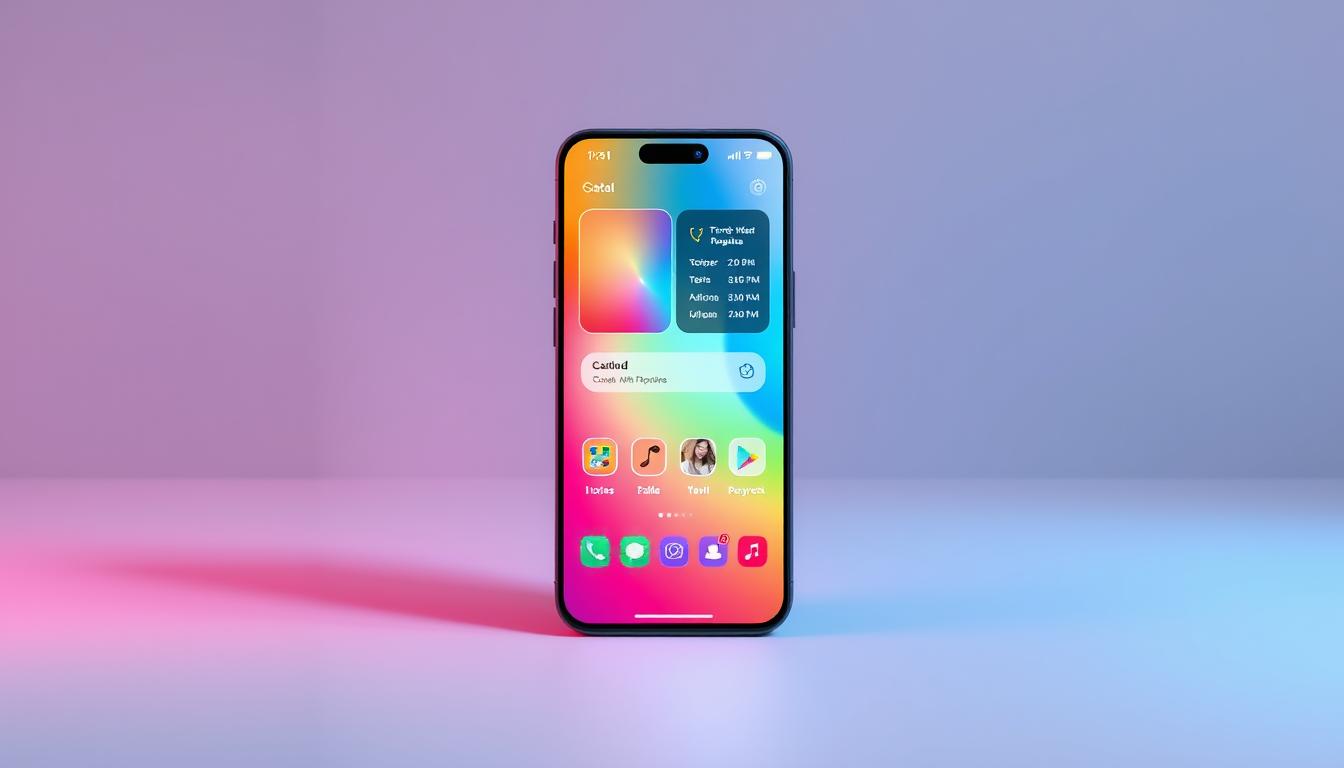In the fast-changing world of mobile tech, an app’s success often depends on its UI and UX design. Mobile users want smooth, easy, and beautiful experiences. So, learning to make stunning UI/UX designs for mobile apps is key for developers, designers, and product managers.
This guide will cover the basics and advanced tips for creating top-notch UI/UX designs for mobile apps. We’ll dive into the fundamentals of mobile design and share strategies to boost user engagement. You’ll learn how to make mobile experiences that grab your audience’s attention and encourage meaningful interactions.
This guide is for both experienced designers and newcomers to mobile app development. It will give you a strong base and practical tips to improve your UI/UX design skills. By the end, you’ll know how to design mobile apps that are not just beautiful but also offer amazing user experiences.
Understanding the Fundamentals of UI/UX Design, Mobile Apps
Exploring mobile app development means learning about UI (User Interface) and UX (User Experience) design. These two are key, shaping how users interact with your App Development. They make the experience smooth and easy to use.
Key Principles of Mobile Design
In Mobile UI design, simplicity, clarity, and quickness are vital. Users often use apps on the move, with small screens. Good navigation and simple design boost Interaction Design and user happiness.
The Relationship Between UI and UX
UI and UX work together. UI deals with the app’s look and feel, while UX looks at the whole experience. Finding a balance between them makes your app both good-looking and easy to use.
Mobile-First Design Approach
In today’s world, focusing on mobile design is key. This approach makes sure the app works well on small screens first. Then, it’s adapted for bigger screens. This way, your App Development meets the needs of your audience.
Essential Tools and Software for Mobile App Design
Creating stunning UI/UX designs for mobile apps requires the right tools. We use a variety of platforms and applications to improve our workflow. This helps us make the user experience better.
Adobe XD is a top choice for mobile app design. It lets us create detailed prototypes, work with teams, and get feedback from users. For a simpler option, Figma is great. It’s a cloud-based platform for real-time collaboration and design changes.
We also use tools like InVision and Marvel for prototyping. They turn our designs into interactive experiences. We can test user flows and get insights to improve the app’s UI/UX.
For smooth collaboration and project management, we use Trello and Asana. These tools help us stay organized and keep everyone on the same page.
With these powerful tools, we create mobile apps that look great and work well. They offer a seamless and engaging user experience.
Research and User Analysis Methods
Creating great mobile app designs starts with knowing our users well. We use various research and analysis methods to learn about their likes, behaviors, and problems. This human-centered design approach helps us make mobile experiences that meet and exceed user expectations.
Conducting User Research
User research is key to a successful mobile app design. We use interviews, focus groups, usability tests, and more to understand users’ needs and goals. This way, we get valuable user experience data to guide our design choices.
Creating User Personas
With insights from user research, we create detailed user personas. These personas help us connect with our users, see their experiences, and make designs that meet their needs. By focusing on our personas, we make mobile apps that truly connect with our users.
Understanding User Journey Maps
We also create user journey maps to improve our user experience approach. These maps show the user’s interactions, emotions, and challenges with our app. By mapping these journeys, we find ways to make the app flow better and be more enjoyable for users.
By using these research and analysis methods, we gain a deep understanding of our users. This human-centered design approach is the key to creating stunning, user-friendly, and engaging mobile apps. These apps captivate our audience and build lasting loyalty.
Designing Intuitive Navigation Patterns
Creating an intuitive navigation system is key in mobile app design. Users want an easy-to-use interface that lets them explore and interact smoothly. Good navigation patterns improve the User Interface and greatly affect the user experience.
Understanding user behavior and preferences is crucial for designing intuitive navigation. By analyzing user research and using Interaction Design best practices, we can make navigation flows that feel natural and meet user needs.
Placing menus and controls strategically is important for intuitive navigation. Making sure important functions are easy to find, while keeping the layout clean, helps users navigate confidently.
Using familiar gestures and interactive elements also makes navigation smoother. Common mobile UI patterns like swipe, tap, and drag-and-drop make your app feel easy to use.
By focusing on intuitive navigation, you can make your mobile app a joy to use. This leads to more engagement, retention, and satisfaction with your Mobile UI.
Color Theory and Visual Hierarchy in Mobile Design
In mobile app design, color theory and visual hierarchy are key. They help capture users and improve their experience. By using color psychology and creating clear visual hierarchies, we make mobile interfaces both beautiful and easy to use.
Psychology of Color in Apps
Colors deeply affect our emotions and views. In app design, we use this to get certain reactions from users. Warm colors like red and orange show energy and urgency. Cool colors like blue and green bring calm and trust.
Choosing the right colors can change how users feel about your app. It shapes their experience.
Creating Effective Visual Hierarchies
A clear visual hierarchy is vital for guiding users in your app. It makes sure key info and actions are easy to find. We use size, placement, color contrast, and typography to focus the user’s attention.
This helps draw the user to the most important parts of the app.
Typography and Readability
The type of typography used in app design affects readability and looks. The right font, size, and spacing make content clear. This makes it easier for users to use your app.
Good typography enhances the visual hierarchy. It ensures a smooth user experience.
Implementing Responsive Design Elements
Mobile devices keep getting better, making it key to have user experiences that adapt. We’ll look at how to make layouts, images, and components flexible. This ensures a smooth mobile experience on all devices and orientations.
A responsive Responsive Design approach is vital for great Mobile UX in mobile apps. We use flexible grids, fluid typography, and dynamic media. This way, our App Development solutions adjust to the user’s device. They work well on any screen size or orientation.

Responsive design lets us change content and layout for different screens. We use relative units and media queries to do this. This makes sure the app looks good on any device.
Responsive design also means handling images and media well. With responsive image patterns, we make sure images fit and look good on all devices. This boosts the app’s look and performance.
Creating Engaging Micro-interactions
In the world of mobile app design, making engaging micro-interactions is key. It grabs users’ attention and boosts their user experience. By using animation, designing clear feedback, and improving loading and transitions, we make the app interface fun and smooth.
Animation Principles
Animations are vital in interaction design. They add life and response to your mobile UI. With timing, easing, and movement, we make animations feel natural and smooth. This improves the user experience.
Feedback Mechanisms
It’s important to give users clear and quick feedback in your mobile UI. This builds trust and confidence. Visual, haptic, or sound feedback helps users understand the app’s state and their actions. This leads to a better and more satisfying experience.
Loading States and Transitions
In today’s fast mobile app world, making loading and transitions smooth is crucial. It keeps users engaged and happy. By guiding users through these moments, we show the app’s responsiveness and keep them interested.
Mastering micro-interactions can greatly improve our mobile apps. It captivates users and strengthens their bond with our digital products.
Optimizing App Performance and Load Times
In the world of Mobile Apps, making apps fast and efficient is key. As App Development gets better, we need to keep up. We must make sure our apps are quick, smooth, and work well.
Managing assets well is a big part of making apps fast. By optimizing images, videos, and fonts, we can make our apps load quicker. Using image compression, CDNs, and font subsetting helps a lot.
Code optimization is also very important. Finding and fixing slow parts of our apps makes them better. Techniques like code minification, lazy loading, and smart API calls help a lot.
Using caching can also make our apps much better. Browser caching, service workers, and offline-first strategies help a lot. They make our apps work better, even when internet is slow.

By using these techniques, we can make apps that are not just fun but also super fast. This keeps our apps ahead in the fast-changing world of app development.
Accessibility Guidelines and Best Practices
In UI/UX Design and Mobile UX, making things accessible is key. We follow the Web Content Accessibility Guidelines (WCAG) to make mobile apps for everyone. This means we design with everyone in mind and test our apps to make sure they work for all.
WCAG Standards for Mobile
The WCAG guidelines help us make web content accessible. These rules also apply to mobile apps. We focus on color contrast, clear text, and making apps work with screen readers and keyboards. This ensures our mobile apps are for everyone.
Inclusive Design Principles
It’s not just about following rules; it’s about designing with empathy. We think about all our users and design with their needs in mind. Features like adjustable text sizes and easy navigation help everyone use our apps.
Testing for Accessibility
Testing is crucial to make sure our apps are accessible. We check our apps against WCAG standards and test with different users. This way, we make sure our apps are easy for everyone to use.
Testing and Iterating Design Solutions
In mobile app development, a great User Experience (UX) and User Interface (UI) are key to success. We’ve covered the basics of mobile design, tools, and research techniques. Now, let’s talk about testing and improving our designs.
Testing is vital in design, helping us make our User Experience, App Development, and Mobile UI better. We’ll explore different testing methods like usability testing, A/B testing, and analyzing user feedback. This ensures our designs connect well with our audience.

Usability testing lets us see real users using our app. It helps us find problems and get insights to improve the User Experience. A/B testing, meanwhile, lets us test different designs to see which one works best for our Mobile UI.
Listening to user feedback, both qualitative and quantitative, is also key. By understanding what users need and want, we can make our App Development better. This way, we can give users an amazing experience.
By constantly testing, getting feedback, and improving, we can make sure our mobile app designs meet and exceed user expectations. This leads to better user engagement and satisfaction.
Conclusion
Creating great UI/UX designs for mobile apps needs a deep understanding of the basics. It also requires a keen eye for detail and a willingness to keep learning. We’ve covered key principles, color theory, and responsive elements to help you make stunning and user-friendly mobile experiences.
The world of UI/UX design for mobile apps is always changing. New trends, technologies, and user preferences pop up all the time. By staying up-to-date, trying new things, and focusing on what users need, we can make sure our designs are engaging and easy to use.
When starting your next mobile app design project, use the tips and best practices from this article. Stick to user-centered design, use data to guide you, and stay open to new ideas. With hard work and a love for innovation, you can make mobile app designs that truly impress your users.



